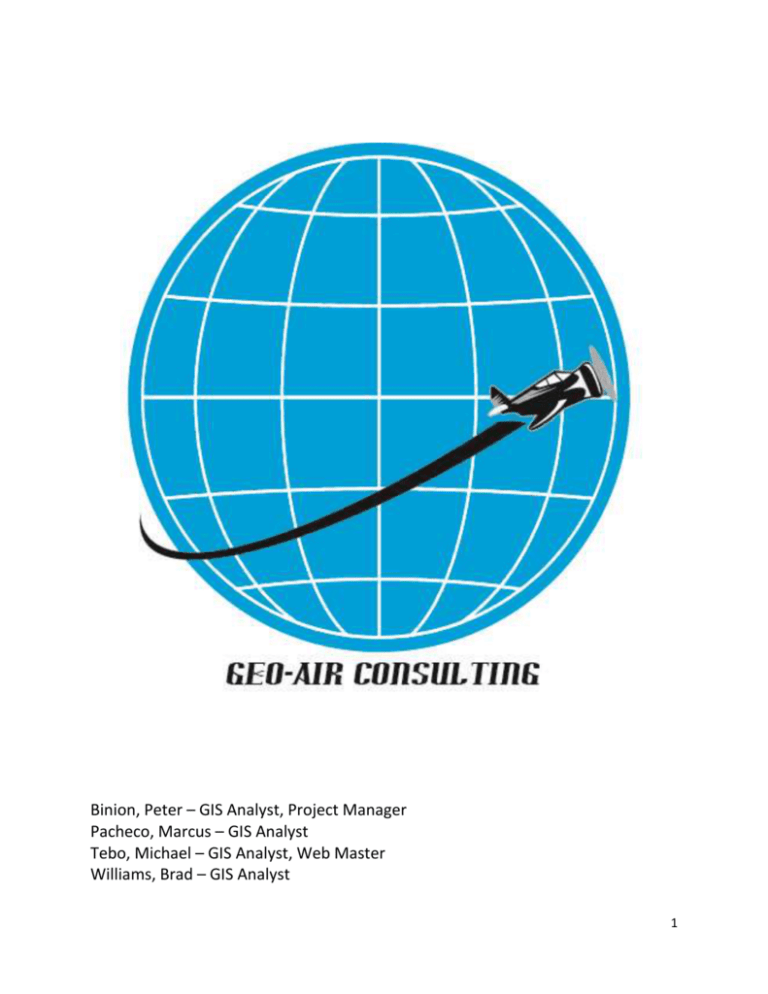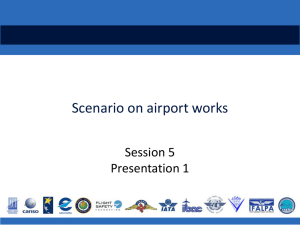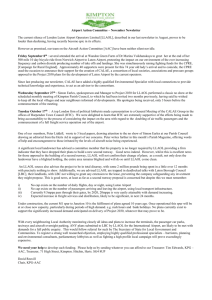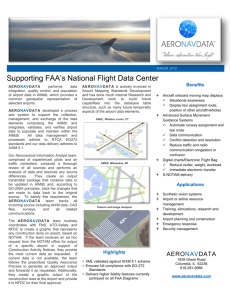Proposal - GeoSites
advertisement

Binion, Peter – GIS Analyst, Project Manager Pacheco, Marcus – GIS Analyst Tebo, Michael – GIS Analyst, Web Master Williams, Brad – GIS Analyst 1 San Marcos Airport Expansion Prepared by: Geo-Air Consulting 2 Table of Contents Introduction Summary…………………………………………………….4 Purpose………………………………………………………4 Scope………………………………………………………….5 Proposal Data…………………………………………………………….5 Analysis……………………………………………………….6 Implications…………………………………………………7 Budget…………………………………………………………8,9 Timetable…………………………………………………….10 Final Deliverables…………………………………………10 Participation..................................................................11 Conclusion…………………………………………………………………11 3 Introduction Summary: Geo-Air Consulting will provide the Texas Department of Transportation (TXDOT), with a planning study focused on extending the length of current operational runway 13-31 and 17-35 at the San Marcos Airport. The study will implement pertinent Federal Aviation Administration regulation regarding the design and safety of runways. Land use compatibility will also be examined based on the Texas Airport Zoning Act. The GIS project will provide TXDOT with suggested outcomes for the suitability of land use compatibility, an airport hazard zoning map, and a solution length for the extension of runway 13-31 and 17-35. Purpose: The first goal of this planning study is to examine the feasibility of extending runways at the San Marcos Airport. If possible, these longer runways could allow growth for the Airport and the City of San Marcos, who owns the facility. These longer runways may attract larger jet aircraft to utilize the facility, which in turn could increase the profitability of the Airport. Two runways will be examined. They are 13-31 and 17-35. The primary precision runway at the Airport is 13-31. This runway has an illuminated lighting system (ILS) for landing planes in inclement weather conditions. Currently, this runway is approximately 5,600 feet in length and 150 feet in width. One goal of this study is to model the extension of this runway to 6,400 feet or a length determined to be suitable based on analysis using GIS. Runway 17-35 is a nonprecision runway which does not have ILS. Runway 17-35 is currently 5,442 feet in length and will be considered for expansion out to 7,000 feet in length. The critical aircraft for this study will be the Gulfstream IV (G450), a jet whose range is 4,350 nautical miles. The maximum fuel payload for the G450 is 29,000 pounds. These characteristics allow this plane to fly non-stop from Dallas to Paris. The second goal of the study is to provide a Controlled Compatibility Land Use map as defined by the Texas Airport Zoning Act. This map will detail current land uses based on aerial photography collected in July of 2012. The extent of this map will correspond with aerial imagery provided by TXDOT. The third goal of this project is to provide an airport hazard zoning map of imaginary surfaces as defined by Federal Aviation Administration code 14 CFR 77. These surfaces will model protected zones as defined by the code for both runways 13-31 and 17-35. The surfaces will include the Runway Protection Zone, Runway Object Free Zone, Runway Safety Area, Threshold Siting Surface, Approach Surface, and the Glideslope Qualification Surface. Analysis of local objects such as trees, houses, or other elevated structures will be tested against the CFR 77 surfaces of runways 13-31 and 17-35. Any consequent penetrations will be recorded. 4 Scope: The extent for this project is two-fold. The ground extent is centered on the San Marcos Airport. Aerial Imagery provided by TXDOT will provide the framework. The imagery measures from N 29.812 to N 29.976 in Latitude, and from -97.768 to -97.965 in Longitude. The corresponding measurement is 11.8 miles of territory East to West, and 11.2 miles from the southern edge to the northern edge. This territory includes parts of Hays county and Caldwell county. This image corresponds roughly with the guidelines for zoning as specified by the Texas Airport Zoning Act, in which land may be zoned 1.5 miles in each direction from the centerline of a runway, and this 3 mile zone then extends 5 miles from the end of each runway. The scope for this project also includes a 50,000 foot zone from the end of each runway which corresponds with several different slopes, defined by FAA 14 CRF 77.19. The slopes are 50:1, 40:1, 34:1, and 20:1. The width of these slopes varies, with a maximum width of 16,000 feet at the maximum length. Proposal Data: Our team has collected and received the data that we will need in order to make the best analysis for the problems that we are aiming to solve. The Texas Department of Transportation provided elevation data and remotely sensed imagery. These aspects include the runways, surrounding buildings, parking lots, utility and fence lines. For all these elements we were able to get the digitized z-values (elevation point) data so we can go in and perform our GIS analysis. Our team has an elevation contour file that we will be using to analyze the elevation changes across the airports extent. We also have shape files of features that surround the airport but are not in the airports boundary. These features are surrounding streets, highways, buildings, and land parcels. This data was obtained from the City of San Marcos via GIS Analyst Joan Hickey in the Planning department. 5 Analysis: This study entails a number of aspects but the main emphasis of the project is a concentration on expanding the runways 13-31 and 17-35 of the San Marcos Airport to meet a desirable ultimate runway length. This task is our first objective that must be taken care of before we can proceed to the creation of a land use map and airport-zoning map. Runway 1331 is of high importance compared to 17-35 because it contains an illuminated light system (ILS), which is essential to planes landing and taking off. This light system is cost sensitive and can amount to high expenses if moved to accommodate the expanding runway. Thus it is vital that we are conscious in our effort to preserve accuracy and validate the accuracy for the extension of runway 13-31. In ArcGIS, we will use a combination of data from Texas Department of Transportation (TXDOT) and the City of San Marcos (COSM) to create a representation showing the definitive extent both runways can reach without conflicting with any subjects that may prohibit this action. These runways must also comply with Federal Aviation Administration guidelines. We will model both runways in ArcGIS using the desired length for each, 6400 feet for runway 13-31 and 7000 feet for runway 17-35, according to the request for proposal from TXDOT. Also included in this study is the creation of maps showing both land use and hazard zoning of the runways and what implications, if any, they may have on the extension of the San Marcos Airport. In creating a controlled compatibility land use map, data from both TXDOT and COSM will be utilized in order to produce a creditable product for the client. "Controlled compatible land use area,” means an area of land located outside airport boundaries and within a rectangle bounded by lines located no farther than 1-1/2 statute miles from the centerline of an instrument or primary runway and lines located no farther than five statute miles from each end of the paved surface of an instrument or primary runway.” Using an aerial image provided by TXDOT and shapefiles of land parcels, zoning areas, streets, railroads, subdivisions provided by COSM, a deliverable map will be produced that conform to standards of the Texas Airport Zoning Act. In addition, an airport hazard-zoning map of imaginary surfaces will be provided to illustrate any complications found penetrating the surfaces. With the aid of the Federal Aviation Administration code 14 CFR 77, we can interpret the imaginary surfaces for both the runways in question. The analysis of surfaces such as runway protection zone (RPZ), threshold siting surface (TSS), approach surface (AS), glideslope qualification surface (GQS), runway safety area (RSA), and runway object free zone (OFZ) will be included in the assessment. Ultimately, we will attempt to exemplify any obstructions that penetrate these surfaces in a plan view oriented map distinguishing each zone by color so it is apparent what surfaces are being breached by an object. The aerial image provided by TXDOT includes z-values of elevation, and with the aid of ArcGIS, we can extract these elevation values from the image, create a TIN model (triangular integrated network) and specify where impediments exist and how we can fix or evade them. The discovery of any obstructions is vital, as the safety of the airport is dependent on following these regulations. 6 Implications: Our outcomes and final product should benefit the City of San Marcos Airport and the Texas Department of Transportation in their efforts to achieve an ultimate runway length in accordance with the findings of the Land Use and Airport Hazard Zoning maps. With the aid of these new maps and a calculated approach to a definitive runway length, the airport should be able to accommodate the Gulfstream IV (G450) and many other aircrafts to help revitalize this airport as a growing entity. Through the assistance of a land use compatibility map, the airport and its staff will visually perceive areas where they can be allowed to expand under the ordinance of the Texas Airport Zoning Act. It will also help the airport delineate its borders and educate them on spaces where growth is limited due to uncontrollable matters. In addition, the creation of an airport hazard-zoning map will benefit the airport to regulate the imaginary surfaces administered by the Federal Aviation Administration while attempting to reach a desirable runway length. This visual aid will allow our client(s) to easily identify where an intrusion exists and if they can resolve the issue and prevent future obstructions. The airport hazard-zoning map will ultimately serve as a guide, in accordance with the CFR 77, for navigable airspace over the San Marcos airport. The hazards zoning map will keep both the community and air travel safe. Lastly, our hopes from this assessment is to contribute in any way or form to the efforts of the expansion of the San Marcos Airport that will allow more profitability, business, and recognition for the airport and the city of San Marcos. 7 San Marcos Airport Project Budget: Data Collection Total Hours (10 hours/week * 5 weeks * 4 consultants + 5 hours /week *5 weeks * 1 consultant) 225 Hourly Pay $30.00 Total $ 6,750.00 Data Analysis Total Hours (10 hours/week * 5 weeks * 4 consultants + 5 hours /week *5 weeks * 1 consultant) 225 Hourly Pay $ 40.00 Total $ 9,000.00 System Management Project Manager Total Hours 50 Hourly Pay $ Pay $ 3,500.00 Total 70.00 $ 3,500.00 Equipment Costs Supplies ($150/ workstation * 4 workstations) $ 600.00 Maintenance ($200/workstation * 4 workstations) $ 800.00 Depreciation ($6,000[total value of computers]/36 (equip 8 life in months)* 2.5 (months equipment will be in exclusive use for project) $ 417.67 Total Equipment Costs $ 1817.67 Data Costs Software Costs Use of ArcGIS license ( $25,000/ 12 * 2.5) Total Software Costs $ 5208.33 $ 5208.33 Due to local client, travel cost not figured. TOTAL COSTS $ 26,276.00 9 Timeline: Team Action Week of Oct 1,2012 Week of Oct 8,2012 Week of Oct 15,2012 Week of Oct 22,2012 Week of Oct 29,2012 Week of Nov 5,2012 Week of Nov 12,2012 Week of Nov 19,2012 Week of Nov 26,2012 Week of Dec 3,2012 Data Collection Data Analysis Data Evaluation Data Quality Evaluation Website Integration Final Deliverables Final Deliverables: We, at Geo-Air Consulting, will provide the following at the end of the Fall 2012 Semester: Detailed Final Report ( 2 Copies) Professional Poster for display in the Geography Department CD ( 2 Copies) containing: All data Metadata Report Poster PowerPoint Presentation Instructions on how to use CD Readme file Testing will be conducted to ensure all data is usable and that no corruption has occurred. 10 Participation Our team did our best to divide everything as equally as possible. Peter Binion wrote the Introduction section of the proposal and then we divided up the rest of the proposal between the remaining three teammates. Brian Williams worked on the Budget, Timetable, and Final Deliverables. Michael Tebo worked on the Data section and the Participation area. Marcus Pacheco did the Analysis, Implications portions on the proposal and prepared the proposal presentation power point. Peter Binion Team Manager - Introduction of Proposal Marcus Pacheco Graphic Design/GIS Analyst- Analysis Proposal, Logo and Power Point Michael Tebo Web Master/GIS Analyst - Data & Consequences/Participation Proposal Brian Williams GIS Analyst - Budget & Timetable Proposal Conclusion Our team will ultimately be providing the Texas Department of Transportation with options for extending the two runways at the San Marcos airport. A determination will be made on the feasible length for runways 13-31 and 17-35. We will be providing a land use compatibility map, an airport hazard zoning map, and a report on penetrations of imaginary surfaces, if any, that compromise the runways’ flight paths. These two maps will provide TXDOT and the San Marcos airport with valuable information that can be utilized for the future expansion of the runways. Our team is also considering making a 3D model of the penetrations of imaginary surfaces. This would help these organizations be able to visualize these surfaces much better and thus make more educated decisions concerning approach and departure procedure. Our team feels that these components will be valuable assets for these two organizations to use in the future. 11






